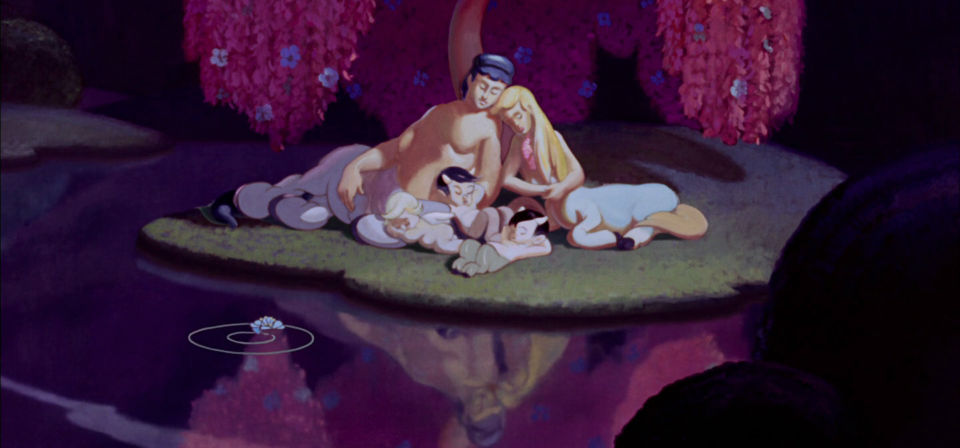Fantasia: The Sistine Chapel of Disney animation
In 1995, when the Pontifical Council for Social Communications included Disney’s 1940 masterpiece Fantasia among the 15 films in the “Art” category on the Vatican film list, the film had only ever been available on home video for a 50-day window in 1991 — a release Disney claimed at the time would never be repeated. Since then, Fantasia has gone on to DVD and Blu-ray releases — and now, mirabile dictu, it is streaming on Netflix in the USA (along with its forgettable 2000 sequel).
Among a few Disney films deserving of the title “masterpiece,” Fantasia remains a unique achievement. Years ago I dubbed it “the Sistine Chapel of Disney animation” — an analogy primarily intended to reflect the diversity and grandeur of its various component segments, but also evoking the film’s use of classical, cosmological and architectural motifs as well as the structural use of classical music, culminating in the moral duel of darkness and light in Mussorgsky’s “Night on Bald Mountain” and Franz Schubert’s “Ave Maria.”
The analogy could be extended and developed further. For instance, the most iconic image in the Sistine Chapel, in the ceiling’s central triptych, is certainly “The Creation of Adam,” with God’s hand not quite touching Adam’s hand. Among the most iconic images in Fantasia is an obviously analogous image: Mickey shaking hands with conductor Leopold Stokowski.
Stokowski is not of course Mickey’s creator, but his role conducting the music of Fantasia does give him a certain “godlike” status within the film’s animated worlds — a status overtly evoked in the opening sequence, Bach’s “Toccata and Fugue in D Minor,” with Stokowski’s silhouette superimposed over abstract shapes and colors, rays of light leaping skyward at the conductor’s gestures. This sequence of light and darkness, coming at the very beginning of the film, corresponds strikingly with the first panel in the chapel ceiling, the creation of light and darkness on the first day of creation.
The second piece, Tchaikovsky’s “Nutcracker Suite,” is a mythological meditation on the seasons of the year, on plants, flowers, water, fish, frost and snow — on the created order covered in the next two panels of the first triptych. (Of course Fantasia later offers a naturalistic “creation story” drawn from evolutionary science, paired with Stravinsky’s “Rite of Spring.”)
“The Nutcracker Suite” is followed by “The Sorcerer’s Apprentice,” a morality tale of disobedience and consequences, providing a sort of counterpart to “The Fall of Adam and Eve” (part of the same central triptych as “The Creation of Adam”). Notably, “The Sorcerer’s Apprentice” depicts Mickey, wearing the sorcerer’s cap, engaging in precisely the same sort of “conducting” behavior as Stokowski in the “Toccata and Fugue,” directing the movements of stars, winds and waters in time with the music — taking on a “divine” role, like Adam and Eve succumbing to the temptation to be like God. The flood that follows Mickey’s disobedience could also be connected to the Noah triptych.
Even the pagan imagery paired with Beethoven’s “Pastoral Symphony” finds a counterpoint in the five pagan sibyls in the Sistine Chapel ceiling. Of course the whole style of Michelangelo’s ceiling, through Judeo-Christian in content, is permeated by the same classical or pagan aesthetic influence reflected in Disney’s “Pastoral Symphony” imagery (though filtered here through Maxfield Parrish and other influences).
Finally, as Michelangelo’s fearful full-length fresco “The Last Judgment,” with its demonic imagery in the lower right corner, dominates the chapel, so the fearful, demon-filled “Night on Bald Mountain” looms large in Fantasia, coming as it does in the last sequence and somewhat overshadowing the less boldly imagined “Ave Maria.” Michelangelo’s beatific image of Christ returning in triumph finds a dim counterpoint in the banishing of the demon Chernabog and his minions at the first pealing of the church bell and the first rays of the rising sun.
All of this only make the relative disappointment of the climactic “Ave Maria” sequence more acute. The sequence was originally conceived as a literal cathedral adorned with stained glass and famous Madonna (and Madonna and child) images — a female presence balancing the male demon of the previous sequence. During development, though, Disney backed away from this overtly Catholic imagery, opting instead for cathedral-like forest imagery. Had it not been for this relative failure of nerve or imagination, Fantasia might have become something grander than the Sistine Chapel of Disney animation; it might have been the Sistine Chapel of animation, period.
Related
Fantasia and Fantasia 2000: Revisiting the Sistine Chapel of Disney Animation
(Newly available on Blu-ray/DVD) Rather than a static motion picture, Fantasia was originally conceived as a repertoire, a selection of presentations that over time could be augmented by new pieces while old ones were retired, like an orchestra rotating its concert lineup … Ten years ago, amid the wreckage at the end of the 1990s Disney Renaissance, the Disney studio marked Fantasia’s 60th anniversary with Fantasia 2000, a film intended to honor in a way the original repertory conception of Fantasia.

Fantasia (1940)
If Fantasia failed to spark a hoped-for entertainment revolution, its achievement is all the more starkly singular. A joyous experiment in pure animation, an ambitious work of imaginative power, a showcase of cutting-edge technique, and a celebration of great music, it is without precedent and without rival. I’ve watched it far too many times to count, and I have yet to begin tiring of it.
Recent
- Benoit Blanc goes to church: Mysteries and faith in Wake Up Dead Man
- Are there too many Jesus movies?
- Antidote to the digital revolution: Carlo Acutis: Roadmap to Reality
- “Not I, But God”: Interview with Carlo Acutis: Roadmap to Reality director Tim Moriarty
- Gunn’s Superman is silly and sincere, and that’s good. It could be smarter.
Home Video
Copyright © 2000– Steven D. Greydanus. All rights reserved.